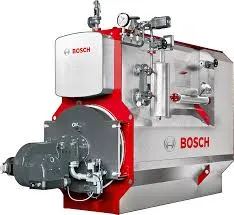
Nov . 06, 2024 16:50 Back to list
Understanding the Definition and Functionality of Steam Boilers in Industrial Applications
Understanding Steam Boiler Definition and Functionality
A steam boiler is an essential device used in various applications, primarily for generating steam through the heating of water. Its importance stretches across numerous industries, including power generation, manufacturing, and heating systems, highlighting its integral role in both industrial and residential settings. This article delves into the definition, functionality, and types of steam boilers, along with their applications and maintenance considerations.
Definition of Steam Boiler
At its core, a steam boiler is defined as a closed vessel in which water is heated to produce steam, usually under pressure. The heating process can be accomplished through various means, such as combustion of fossil fuels, electrical heating elements, or through the absorption of heat from other sources. The generated steam can then be utilized for a multitude of purposes, including heating, powering turbines for electricity generation, and serving as a driving force for various machinery and processes.
Functionality of Steam Boilers
The primary function of a steam boiler is to convert water into steam efficiently while ensuring safety and reliability. Here’s how the process typically works
1. Water Input The boiler is filled with water, which is often treated to prevent scaling and corrosion.
2. Heat Generation Heat is then applied to the boiler through the combustion of fuel, such as natural gas, oil, coal, or the use of electrical elements.
3. Steam Production As the water heats up, it reaches its boiling point, resulting in the formation of steam. This steam can be produced at varying pressures and temperatures, depending on the design of the boiler and the intended applications.
4. Steam Distribution Once produced, steam is directed through pipes to wherever it is needed, whether to heat a building, power equipment, or feed into a turbine for electricity generation.
5. Condensation and Return After the steam has performed its work, it cools down and condenses back into water. This condensate is usually returned to the boiler for reuse, creating a closed-loop system that maximizes efficiency.
Types of Steam Boilers
There are several types of steam boilers, each designed for specific applications and operating conditions
1. Fire-Tube Boilers In these boilers, hot gases produced from combustion pass through tubes surrounded by water. They are commonly used in small-scale applications and are known for their simplicity and ease of maintenance.
2. Water-Tube Boilers Conversely, water-tube boilers have water-filled tubes that are heated externally by hot gases. They can operate at higher pressures and are often used in larger industrial applications.
steam boiler definition

3. Electric Boilers These devices use electrical energy to heat water, providing a cleaner alternative to traditional fuel-based systems. They are often used in applications where a quick response time and precise temperature control are required.
Applications of Steam Boilers
Steam boilers are versatile and can be found in various applications, including
- Power Generation Many power plants utilize steam boilers to produce electricity. The steam generated drives turbines that convert thermal energy into electrical energy.
- Industrial Processes Numerous manufacturing processes, such as chemical production, food processing, and textile manufacturing, rely on steam for heating, drying, and powering machinery.
- Heating Systems In buildings, steam boilers are commonly used for heating spaces through radiators or underfloor heating systems, providing warmth in colder climates.
Maintenance Considerations
Maintaining a steam boiler is crucial for ensuring its efficiency and safety. Regular inspections and maintenance checks should include
- Checking Pressure Levels Ensuring that pressure readings are within safe limits to prevent accidents.
- Water Quality Management Regular testing and treatment of water are necessary to prevent scaling and corrosion.
- Inspecting Safety Valves Safety devices must be checked frequently to ensure they function correctly and can handle any unusual pressure spikes.
- Cleaning Regular cleaning of both the fire and water sides of the boiler helps maintain efficiency and longevity.
Conclusion
In conclusion, steam boilers are vital components in many industrial and residential applications, generating steam for heating, power generation, and various manufacturing processes. Understanding their definition, functionality, types, and maintenance requirements not only highlights their significance but also ensures their safe and efficient operation. Proper management and care of steam boilers contribute to the reliability of the systems they support and play an essential role in the functioning of modern industry.
-
High-Efficiency Commercial Oil Fired Steam Boiler for Industry
NewsJul.30,2025
-
High-Efficiency Biomass Fired Thermal Oil Boiler Solutions
NewsJul.30,2025
-
High Efficiency Gas Fired Thermal Oil Boiler for Industrial Heating
NewsJul.29,2025
-
High-Efficiency Gas Fired Hot Water Boiler for Sale – Reliable & Affordable
NewsJul.29,2025
-
High Efficiency Biomass Fired Hot Water Boiler for Industrial and Commercial Use
NewsJul.29,2025
-
High-Efficiency Biomass Fired Hot Water Boiler for Industrial Use
NewsJul.28,2025
Related PRODUCTS






















